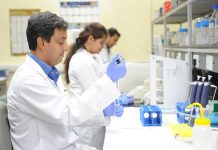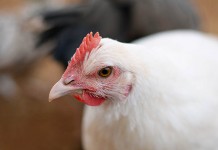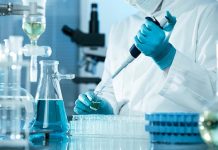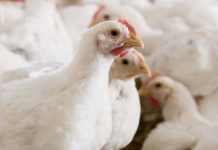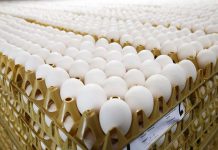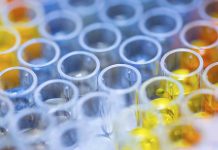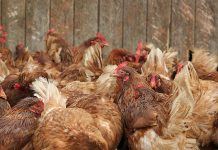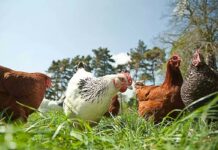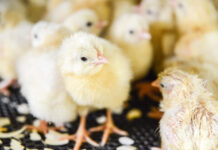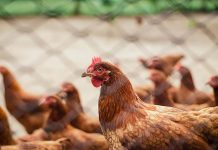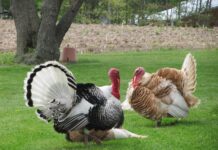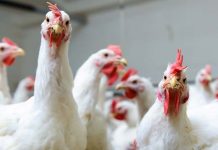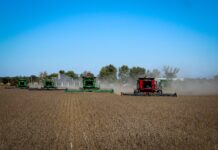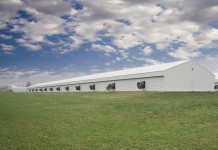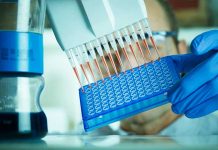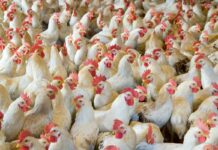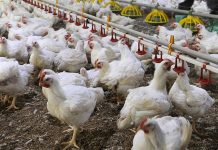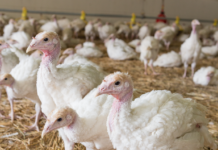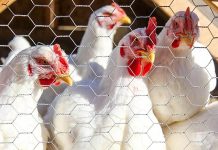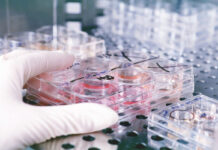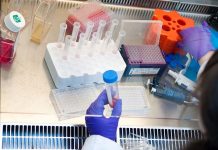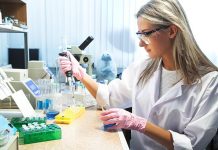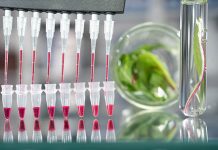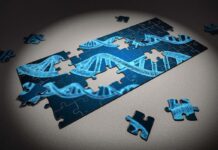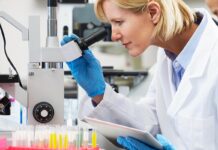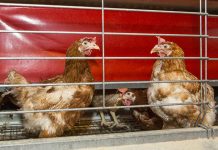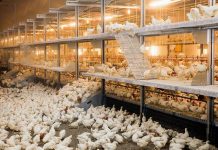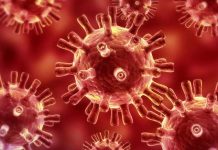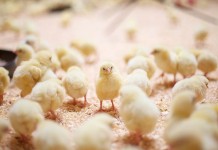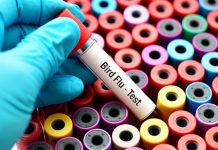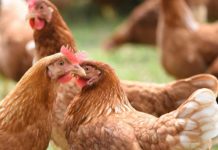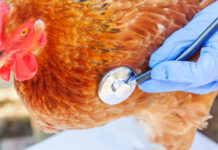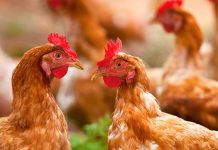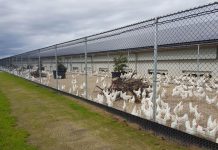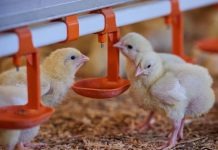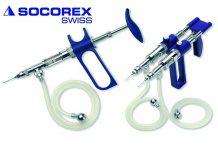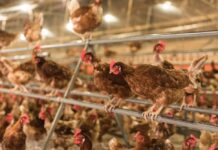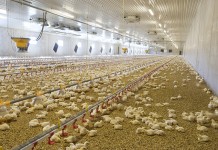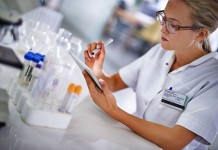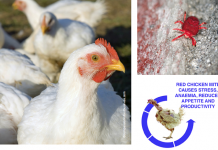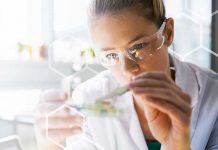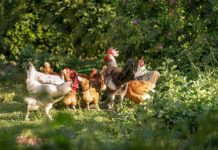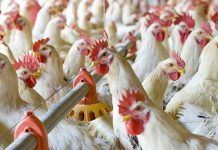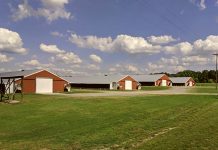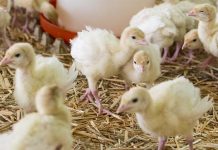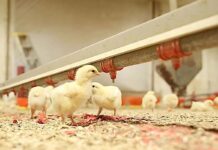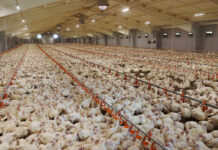Compatibility of a new multi-strain probiotic with a live-attenuated Salmonella vaccine in chickens
A pilot study was undertaken to assess the compatibility of a new multistrain probiotic with a live-attenuated Salmonella Typhimurium (ST) vaccine. Experimental units were...
Quality Control Audits of killed vaccination
Vaccination programs for breeders and egg layers include procedures with inactivated vaccines. Killed (inactivated) vaccines are used to prevent disease in the vaccinated bird...
The Omics revolution – Implications for animal production
What does Omics mean?
Omics is a term that refers to the recently developed high throughput technologies that include genomics, functional genomics (transcriptomics), proteomics, and...
Effect of difference doses of Newcastle disease vaccine immunization on broilers
Influence on growth performance, plasma variables and immune response
As a member of the Paramyxoviridae group, Newcastle disease virus (NDV) is the key causative agent...
Non-antibiotic intestinal interventions
As the countdown towards implementation of the FDA’s Guidance for Industry 213 continues, interest in non-antibiotic intestinal interventions has increased. Earliest efforts in this...
Analysis of anti-Ascaridia galli antibody levels in egg yolk to detect parasite infection in...
In recent years, in response to consumer concerns regarding welfare of birds, there has been a move from caged to free-range production systems. This...
Comparing two ELISA kits
Here a comparison of two ELISA kits as been made to assess their efficicacy.
Recombinant turkey herpesvirus vaccines (rHVT) are being widely used for...
Obtaining the most benefit from an anticoccidial sensitivity test
The poultry industry has been using the same anticoccidial drugs for the prevention of coccidiosis for several decades. The last approval of a new...
Cochlosoma anatis in turkeys
A funded research project at North Carolina State University in Raleigh, N.C. evaluated the pathogenicity of Cochlosoma anatis. The research was made possible in...
Rapid in vitro antimicrobial screening assay against Campylobacter
Research was undertaken to adapt a multi-well antimicrobial assay as a fast and reliable method to screen large numbers of plant extract treatments against...
Key global health issues in cage-free and organic laying hens
In USA and Europe there has been a growth in cage-free, free range, and organic production over the last 10 years.
The percentage of all...
NWO OTP grant awarded to WUR project aimed at head start for day-old chicks
The immune system of a chicken starts in the egg. Validated tools to assess how incubation conditions influence immune development are lacking. A new...
Protecting poultry from Avian Influenza
The Avian Influenza season is upon us, but how much do you know about Avian Influenza? Do you know how to protect the birds...
Targeted preharvest interventions against Salmonella in turkeys
Salmonella is a foodborne zoonotic pathogen prevalent in poultry production, including turkeys. The pathogen is a constant threat to human public health because of...
Incorporating an essential oil and saponin blend as part of an effective coccidiosis management...
Coccidiosis continues to be a top challenge in the poultry industry and growing evidence of reduced sensitivity to traditional anticoccidials like ionophores and chemicals...
Characterizing litter mite communities. Applications of DNA barcoding for management strategies
The use of DNA barcoding can facilitate rapid biodiversity assessments of fastidious taxa - litter mite communities - by delineating species using molecular operational...
Development of Multilocus sequence typing (MLST) for Mycoplasma gallisepticum
Mycoplasma gallisepticum (MG) is the most pathogenic avian mycoplasma species. It affects commercial, non-commercial poultry and wild birds. Current MG sequence typing methods rely...
Animal feed probiotics market expands as antibiotic-free nutrition gains momentum
The global animal feed probiotics market is undergoing a significant transformation as livestock producers increasingly seek sustainable, science-driven alternatives to conventional growth promoters. Valued...
Enhancing biosecurity using flow analysis and Danish entry concepts
The term Danish entry is commonly used to describe entryways to livestock buildings that help people enter barns in a relatively bio secure way...
Host and microbial biomarkers for intestinal health and disease in broilers
New tools can be used to determine the gut health status of animals and to predict animal performance or to make a decision whether...
Clinical coccidiosis in broilers with concurrent infection of Eimeria maxima and Eimeria praecox
Coccidiosis is a complex disease in chickens caused by protozoan parasites in the genus Eimeria. As Eimeria species are ubiquitous in poultry facilities, coccidiosis...
DNA region in chickens identified for disease resistance
One region in the DNA explains a large difference in possible disease resistance betweenchickens. This was discovered by researchers of Wageningen University & Research...
Active and passive Salmonella surveillance systems
Two surveillance systems have been established in France for the monitoring of antimicrobial resistance (AMR) in Salmonella enterica subsp. enterica isolated from the agro-food...
The ABCs of CDT (Clostridial Dermatitis of Turkeys)
Clostridial Dermatitis of Turkeys (CDT), also referred to as Cellulitis, remains a major disease issue across all geographic regions of the US; the annual...
Enumeration of Ascaridia Galli eggs in chicken excreta
Excreta counting techniques in eggs can provide valuable information for assessing flock infection levels, selecting nematode resistant chicken breeds and for determining anthelmintic efficacy.
Although...
Prevalence and antimicrobial resistance of thermophylic Campylobacters in poultry
Campylobacter spp. is a leading cause of foodborne diarrhea. The most common source of infection is contaminated food, mainly poultry meat.
The uncontrolled use of...
Research shows nutritional effects of Coccidiosis vaccination
A funded research project on Coccidiosis was completed at the University of Arkansas in Fayetteville, Arkansas, that shows the nutritional effects of coccidiosis vaccination.
Project...
Future of coccidiosis management in turkeys
Coccidiosis is a disease that is caused by protozoan parasites that develop within the intestine of most domestic and wild animals and birds. Coccidia...
Infectious Laryngotracheitis (ILT) outbreaks in laying hens in Konya province
Infectious laryngotracheitis (ILT) epidemic cases characterized with respiratory symptoms, hemorrhagic tracheitis and laryngitis findings were identified in laying hen’s enterprises in Konya province.
Ten Lohman-breed...
Salmonella Reading in commercial turkeys. Why now and how?
Salmonella sp. is one of the most common bacteria associated with foodborne illness in humans. Each year in the United States, foodborne salmonellosis causes...
Novel Approach Improves Poultry Welfare by Reducing Stress on Chickens
MSD Animal Health (known as Merck Animal Health within the United States and Canada) recently announced the launch of EXZOLT® (fluralaner), the first systemic...
Understanding resistance to different Infectious Bronchitis virus genotypes
In previous experiments, we have challenged major histocompatibility complex (MHC) congenic chicken lines available at UC Davis with an infectious bronchitis virus (IBV) M41...
UK Veterinary Vaccinology Network
Veterinary researchers from around the world came together at this year’s joint UK & International Veterinary Vaccinology Network Conference on the 9-10 January 2019...
Testing day-old poults
When poults are received at a farm from the hatchery they should be good quality poults; namely, free from physical defects, actively looking for...
How Marek’s disease may directly affect the chicken immune system
Marek’s disease virus (MDV) causes disease in chickens and is estimated to cost the global poultry industry up to US $2 billion each year.
In...
Alternatives to antibiotics in organic poultry
Organic poultry production is one of the fastest growing segments of organic agriculture with a 20% average annual increase since the establishment of the...
Female persistency post-peak. Managing fertility and production
INTRODUCTION
Managing breeding stock fertility and egg production is critical to achieving good breeder production and welfare. However, maintaining persistent egg output and hatchability remains...
The effects of diet and epigenetic alterations on the gut microbiome, inflammation and poultry...
The gut microbiota is a fundamental force influencing diverse aspects of avian physiology. Microbiome studies are at a critical juncture and facing a challenging...
Infectious bronchitis virus shuts down cell stress signals
A new study from scientists at The Pirbright Institute and collaborators at the University of Surrey provides evidence that infectious bronchitis virus (IBV) can regulate the...
A diagnostic laboratory perspective for pathogen detection
Detection of infectious diseases can generally be broken down into laboratory detection of the pathogen or detection of the immune response to the pathogen....
Researchers characterize selected variant Avian Reovirus strains
USPOULTRY and the USPOULTRY Foundation announce the completion of a funded research project at the University of California, Davis, in which researchers looked to...
Gut health in poultry production: why, what and how
Gut health has become a dominant topic in the global poultry industry. But why did the topic emerge to become so important to the...
Blackhead disease: development of molecular tests and an in vitro assay to identify reservoirs...
This research project developed diagnostic assays needed for advancing the understanding of blackhead disease. The article shows clearly how the disease most likely spreads...
Comparison of four injection sites for Se bacterin vaccine in commercial pullets
As commercial pullets farming transitions from rearing a bird on a single level in conventional-style housing to rearing a bird in a multi-level aviary,...
Clostridial Dermatitis
Clostridial Dermatitis is a disease of economic concern in turkeys. Clostridium perfringens and Clostridium septicum have been isolated consistently from dermatitis lesions in turkeys....
Pirbright’s livestock coronavirus research
The Pirbright Institute is aware that misinformation regarding the Institute and its research is circulating on social media following an outbreak of a new...
Integrated Microfluidic Device for rapid Avian Influenza virus capture
Rapid detection of avian influenza virus (AIV) is highly desirable during outbreaks or routine AIV surveillance.
In this project, the preliminary results in developing a...
How a single Avian Influenza protein can increase period of infection
New research led by scientists at The Pirbright Institute has shown how an Avian Infuenza a virus protein, called PB1-F2, is able to shut...
Influenza antibodies made by Pirbright reduce disease in chickens
Scientists at The Pirbright Institute have engineered synthetic antibody
molecules that can be administered to poultry to reduce the symptoms of Influenza, as well as...
Reducing antibiotic use without harming profitability is an actual possibility
Ten million people are at risk due to antibiotic resistance, ensures the “Antimicrobial Resistance Review” published by the United Kingdom government in 2014. Of...
Infectious Coryza in vaccinated layers: are vaccines failing to protect?
During 2017 and 2018 Infectious Coryza was detected in several commercial vaccinated egg layer flocks in California. The Avibacterium paragallinarum strains isolated from infected...
Infectious Laryngotracheitis (ILT) Advisory – City of Kingston
The Feather Board Command Centre (FBCC) is issuing an Infectious Laryngotracheitis (ILT) biosecurity advisory for an approximate 10 km area in the City of Kingston.
FBCC...
Research provides Insight on colonization of broilers by Salmonella
USPOULTRY and the USPOULTRY Foundation announce the completion of a funded research project at Auburn University in Auburn, Alabama, in which researchers were able...
Researchers investigate the cause and prevention of False Layer Syndrome
USPOULTRY and the USPOULTRY Foundation announced the completion of a funded research project at the University of Georgia in which researchers investigated the cause and prevention...
Gut health in layers
To some extent gut health has not been a focus of commercial pullet and layer flocks unless the problem contributed to a significant mortality...
A new view of how class I molecules fight diseases
Classical class I molecules of the major histocompatibility complex (MHC) play crucial roles in defence against viruses.
The class I molecules bind pieces of protein...
Biosecurity measures and new vaccines to combat the spread of bird flu
The recent H5N6 bird flu outbreak is confined to the south of England, partly due to the introduction of an Avian Influenza Protection Zone...
Holistic view of intestinal health in poultry
Intestinal health is necessary to maintain efficient and sustainable gastrointestinal tract (GIT) physiology. The GIT has digestive, absorptive, metabolic, immunological and endocrinological functions.
This means...
Use of injection syringes in the animal production industry
Animal health is an important factor to consider, as any disease outbreak can potentially have drastic economical consequences. For this reason, planning and preparing...
Mycoplasma Synoviae, a technical update
Mycoplasma are the smallest free-living organisms both in size and number of genes, and unlike many other bacteria, they do not have a cell...
Detection of antibodies against Chlamydia species in chicken serum
Avian chlamydiosis is a bacterial infection caused by Chlamydia bacteria. The currently available tests distinguish Chlamydia species based on genetic material. Researchers from Wageningen...
Microbiota studies in poultry
The microbial populations that inhabit the gastrointestinal tract (GIT) of birds play an important role in the establishment and maintenance of a healthy gut....
Monitoring of IBV circulation and prevalence
Infectious bronchitis (IB) is one of the most common viral diseases in chicken production worldwide and IB virus (IBV) is considered the most contagious...
Role of dietary calcium in Necrotic Enteritis development and pathogenesis
USPOULTRY and the USPOULTRY Foundation announce the completion of a funded research project at Texas A&M University in College Station, Texas, in which the...
Profiling Salmonella serotypes through broiler processing
USPOULTRY and the USPOULTRY Foundation announce the completion of a funded research project at the University of Georgia in which researchers profiled Salmonella serotypes through broiler processing.
The...
The cost of mycoplasma infection in poultry
Sometimes some Mycoplasma infections cause disease in poultry and this has been extensively studied and worried about by veterinarians, poultry producers and veterinary authorities....
Research reveals method to improve Escherichia coli vaccines
A funded research project at the University of Georgia in Athens, Ga. was completed, in which researchers revealed a method to improve Escherichia coli...
Increased cecal butyrate concentrations protect against Salmonella Enteritidis
Butyrate is a molecule that is extensively studied as a feed additive to improve gut health and animal performance. It also has been described...
Chicken study probes resistance to food bug
Receiving gut microbes from resistant chickens does not lessen chickens’ susceptibility to bacterium that causes food poisoning.
Susceptible chickens became even more susceptible to Campylobacter,...
How Necrotic Enteritis affects animal’ welfare and performance
Necrotic Enteritis (NE) affected flocks have poor enteric health and nutrient digestibility leading to decreased performance and increased excretion of nutrients.
Evidence suggests that...
Wooden Breast Disease
The emergence of Wooden Breast Disease in commercial broiler chickens has been associated with significant economic loss in the poultry industry resulting from severe...
Use of comparative genomics to identify vaccine candidates for Campylobacter Jejuni
Interventions to control and reduce the incidence of Campylobacter jejuni colonization in poultry is important in order to reduce the burden of foodborne illness in humans....
Sample management and handling for diagnostic testing
Diagnostic testing is an important and widely used tool in commercial poultry husbandry. A key to best use of diagnostic testing, is to begin...
An alternative method to fight Avian Influenza Virus
A recent project was completed at the University of Iowa, Iowa City, Iowa, in which researchers developed a mobile system that can inactivate Avian...
Turkey arthritis reovirus. Diagnostic strategies
Avian reoviruses (ARVs). They are non-enveloped viruses of 70-80 nm size having an icosahedral symmetry. The viral genome has 10 segments of double stranded...
Towards practical methods for assessing ILTV vaccine take
In response to ILTV outbreaks, live vaccines are typically administered at 7-14 days of age in drinking water via nipple drinkers which may not...
Engineering vaccines for multiple strains of IBV
In new work funded by a Biotechnology and Biological Sciences Research Council (BBSRC) researchers at The Pirbright Institute and The Roslin Institute have published...
Biological control of Salmonella in the poultry industry: a European perspective
Salmonella remains one of the most important foodborne bacterial pathogens worldwide, and is frequently linked with the consumption of contaminated poultry meat and eggs....
The importance of gut microbiota in chickens
Recent expansion in knowledge about the influence of microbiota on health and disease started a major research revolution in the area. Intestinal systems of...
On-farm control of campylobacter
Campylobacteriosis, primarily caused by the consumption of contaminated chicken products, accounts for the majority of food poisoning cases in Europe and many other developed...


